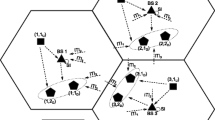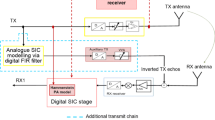Abstract
We consider a three-node full-duplex (FD) network, where an FD capable base station serves double mobile nodes operating in half-duplex mode. The self-interference at the base station and the inter-node interference (INI) between the uplink and the downlink nodes in the network are both taken into account. We consider the power control and the base station assisted INI suppression for sum achievable rate maximization subject to the transmit power constraints at the base station and the nodes. By reformulating this non-convex problem and separating it into two independent sub-problems, we propose a search method to solve it. We evaluate the performance of the proposed method in a single-cell scenario. The proposed method significantly outperforms other recently developed methods.




Similar content being viewed by others
Notes
The processing delay comprises of digital and analog parts. The digital part can be solved by adopting high sampling analog digital converter (ADC) and digital analog converter (DAC), and high digital signal processing using field programmable gate array (FPGA).
The channel information of the uplink, the downlink, and INI channels can be obtained as follows: (1) the uplink node broadcasts training sequences, and the base station and the downlink node estimate the uplink channel and the INI channel; (2) the downlink node sends the training data and then the INI channel information, the base station first estimates the downlink channel and then decodes the INI channel information. To save the training time consume, the channel can be estimated in time-domain.
\(\alpha = 1\) means perfect SI suppression at the base station.
Usually, it can be expected that the SI level will depend on the transmit power at the base station. However, it is hard to solve this problem. For simplicity, we assume that the total transmit power at the base station can always reach the maximum transmit power. On the other hand, we consider the worst case in this paper. In this case, our proposed method can outperform other methods as illustrated in the simulation section. Thus, the assumption for fixed residual SI and noise power here is reasonable.
In fact, the residual SI signal plus noise \(\tilde{s}_{si}\) and the downlink signal \(s_{d}\) are correlated, but it is hard to solve it. So we assume the residual SI signal plus noise \(\tilde{s}_{si}\) and the downlink signal \(s_{d}\) are uncorrelated for simplicity which almost holds when the SI suppression ratio is very high.
The carrier set here represents a subcarrier of the OFDM modulation. In practice, long enough OFDM symbol should be adopted for reducing the influence of propagation difference between the INI and the INI suppression signals.
References
Jain, M., Choi, J. I., Kim, T., Bharadia, D., Seth, S., Srinivasan, K., Levis, P., Katti, S., & Sinha, P. (2011). Practical, real-time, full duplex wireless. In Proceedings of the 17th annual international conference on mobile computing and networking (pp. 301–312).
Duarte, M., Dick, C., & Sabharwal, A. (2012). Experiment-driven characterization of full-duplex wireless systems. IEEE Transactions on Wireless Communications, 11(12), 4296–4307.
Toka, M., Kucur, O., & Tezekici, B. S. (2017). Performance of joint relay and antenna selection in the full-duplex amplify-and-forward relay networks. Wireless Personal Communications, 96(3), 4313–4328.
Kim, D., Lee, H., & Hong, D. (2015). A survey of in-band full-duplex transmission: From the perspective of PHY and MAC layers. IEEE Communications Surveys Tutorials, 17(4), 2017–2046.
Zhang, Z., Long, K., Vasilakos, A. V., & Hanzo, L. (2016). Full-duplex wireless communications: Challenges, solutions, and future research directions. Proceedings of the IEEE, 104(7), 1369–1409.
Wu, F., Li, S., Shao, S., & Tang, Y. (2016). Near-field self-interference suppression with subscriber beamforming in full-duplex communications. AEU-International Journal of Electronics and Communications, 70, 1676–1683.
An, C., & Ryu, H.-G. (2017). Double balanced feed network for the self-interference cancellation in full duplex communication system. Wireless Personal Communications, 92(4), 1599–1610.
Taghizadeh, O., Zhang, J., & Haardt, M. (2016). Transmit beamforming aided amplify-and-forward MIMO full-duplex relaying with limited dynamic range. Signal Processing, 127, 266–281.
Yuan, S., & Liang, Q. (2016). Game theoretical method for sum-rate maximization in full-duplex massive MIMO heterogeneous networks. Signal Processing, 126(SI), 4–11.
Liu, F., Liu, Z., & Bai, Y. (2017). Joint resource allocation algorithms for full-duplex wireless cellular system. Wireless Personal Communications, 96(1), 1299–1312.
Cheng, W., Zhang, X., & Zhang, H. (2013, April). Optimal dynamic power control for full-duplex bidirectional-channel based wireless networks. In INFOCOM, 2013 proceedings IEEE (pp. 3120–3128).
Wang, Y., & Mao, S. (2015, March). Distributed power control in full duplex wireless networks. In 2015 IEEE wireless communications and networking conference (WCNC) (pp. 1165–1170).
Zhang, R., Ma, M., Li, D., & Jiao, B. (2015, June). Investigation on dl and ul power control in full-duplex systems. In 2015 IEEE international conference on communications (ICC) (pp. 1903–1907).
Nam, C., Joo, C., & Bahk, S. (2015). Joint subcarrier assignment and power allocation in full-duplex ofdma networks. IEEE Transactions on Wireless Communications, 14(6), 3108–3119.
Feng, M., Mao, S., & Jiang, T. (2015). Joint duplex mode selection, channel allocation, and power control for full-duplex cognitive femtocell networks. Digital Communications and Networks, 1(1), 30–44.
Al-Imari, M. (2016, September) Theoretical analysis of full-duplex system with power control. In 2016 international symposium on wireless communication systems (ISWCS) (pp. 461–465).
Di, B., Bayat, S., Song, L., Li, Y., & Han, Z. (2016). Joint user pairing, subchannel, and power allocation in full-duplex multi-user ofdma networks. IEEE Transactions on Wireless Communications, 15(12), 8260–8272.
Li, R., Chen, Y., & Wu, Y. (2016). Binary power control for full-duplex networks. In 2016 IEEE 27th annual international symposium on personal, indoor, and mobile radio communications (PIMRC) (pp. 1–6).
da Silva, J. M. B., Xu, Y., Fodor, G., & Fischione, C. (2016). Distributed spectral efficiency maximization in full-duplex cellular networks. In 2016 IEEE international conference on communications workshops (ICC) (pp. 80–86).
Sahai, A., Patel, G., & Sabharwal, A. (2011). Pushing the limits of full-duplex: Design and real-time implementation. arXiv preprint. arXiv:1107.0607.
Bai, J., & Sabharwal, A. (2013). Distributed full-duplex via wireless side-channels: Bounds and protocols. IEEE Transactions on Wireless Communications, 12(8), 4162–4173.
Sahai, A., Diggavi, S., & Sabharwal, A. (2013, September). On degrees-of-freedom of full-duplex uplink/downlink channel. In Information Theory Workshop (ITW), 2013 IEEE (pp. 1–5).
Bi, W., Su, X., Xiao, L., & Zhou, S. (2015, June). On rate region analysis of full-duplex cellular system with inter-user interference cancellation. In 2015 IEEE international conference on communication workshop (ICCW) (pp. 1166–1171).
Bi, W., Su, X., Xiao, L., & Zhou, S. (2016, April) Superposition coding based inter-user interference cancellation in full duplex cellular system. In 2016 IEEE wireless communications and networking conference (pp. 1–6).
Wu, F., Pu, X., Zhang, T., Li, S., MA, W. (2018). An interuser interference suppression approach in full‐duplex wireless communications. Transactions on Emerging Telecommunications Technologies. https://doi.org/10.1002/ett.3234.
Wu, F., Liu, D., & Ma, W. (2018). Mitigation of the inter-node interference in multi-antenna full-duplex networks. AEU-International Journal of Electronics and Communications, 83, 309–316.
Williams, A. (2013). Analog filter and circuit design handbook. New York: McGraw-Hill.
Spatial channel model for multiple input multiple output (MIMO) simulations, 3GPP TR 25.996 V7.0.0 (2007-06). Technical report.
Acknowledgements
The authors would thank Qingpeng Liang for his helpful advice. This work was supported by the National Natural Science Foundation of China (Grant Nos. 61531009 and 61471108); the National Major Projects (Grant No. 2016ZX03001009); and the Fundamental Research Funds for the Central Universities.
Author information
Authors and Affiliations
Corresponding author
Additional information
Publisher's Note
Springer Nature remains neutral with regard to jurisdictional claims in published maps and institutional affiliations.
Rights and permissions
About this article
Cite this article
Wu, F., Liu, D. Power Control and Inter-node Interference Cancellation in Full-Duplex Networks with Residual Self-Interference. Wireless Pers Commun 108, 2371–2388 (2019). https://doi.org/10.1007/s11277-019-06526-4
Published:
Issue Date:
DOI: https://doi.org/10.1007/s11277-019-06526-4




